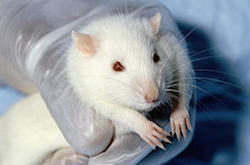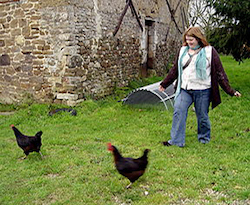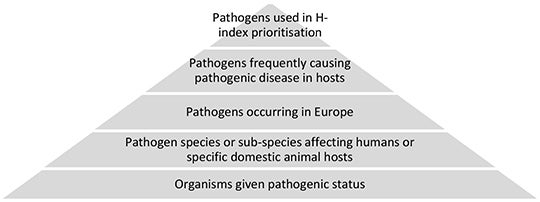
Ranked and Ready: The Most Important Diseases To Study
What’s in the Story

It's no fun when you're sick in bed with the sniffles, but in most cases your doctor can tell you what you can do to get better. What about when we come across an illness we don’t understand or know much about? In that case, even doctors may not have the answers. It can be frustrating trying to find a medicine that can make you feel better.
We don’t know everything about every disease because there hasn’t been research done on all of them. When scientists study a disease, they try to figure out what causes the disease and how to best treat it. But they have to pick and choose which diseases to study. Usually, the diseases that can cause the most widespread harm and have the biggest impact are studied first.
Scientists want to better understand diseases more likely to make people or animals sick. But how do we identify them? In the PLOS ONE article, “A Quantitative Prioritisation of Human and Domestic Animal Pathogens in Europe,” scientists found a new way to determine which diseases carried the biggest risks.
Diseases from A to Z(oonotic)
Scientists wanted to create a list of diseases most likely to affect humans and animals. The first step in this process was to gather information on all known human and animal pathogens. A pathogen is something that causes disease.

To do this, scientists used something called the EID2 database. The EID2 might sound like a droid from Star Wars, but it's not. It is a database that pulls information from other databases about different pathogens. For example, it records where, when, and in which host (animal or human) there is evidence of a pathogen occurring. Here, it gave scientists information to sort the pathogens into different categories.
The first category described how big of a problem the pathogen was. The groups included pathogenic, non-pathogenic, and unknown. Pathogenic diseases are ones that cause significant harm or death more often than not. Non-pathogenic diseases don’t have any medical symptoms. Unknown pathogenic diseases aren't understood enough for scientists to make any conclusions.
The second category described if pathogens were zoonotic or non-zoonotic. Diseases that can pass from animals to humans are called zoonotic diseases. "Zoo" is in the name because they involve animals. When an animal gets a zoonotic disease, they can pass it to humans in many different ways.

For example, some diseases are given to humans when they eat an animal. Others are passed by being near an animal or animal products. For example, some chickens might carry salmonella, which can make humans ill.
The third category defined if the disease affected humans, animals, or both. This is different than the category above. There are diseases that can affect animals and humans, but generally do not spread between them. Scientists made this distinction to see whether the worst diseases were affecting humans, animals, or both groups.
The final category identified a pathogen as emerging or non-emerging. Emerging diseases are those that have appeared in a new place or in a host population for the first time. Non-emerging pathogens are those that continue to affect the same hosts in the same regions.
All of these categories are important for determining which diseases really were the worst of the worst.
Creating Science's Most-Wanted List
All this information about different diseases could potentially be helpful, but scientists wanted it to be easy for other researchers to know which diseases they should study first if they wanted to help the largest amount of people. To do this, they needed to narrow down their list.
To see the impacts each pathogen had on its host population, they used something called the H-index. The H-index is used to keep track of how often something is studied or mentioned in publications or on-going research. If a particular topic, like a certain disease, is mentioned a lot, it will have a high H-index value.
In this case scientists used the H-index to see which diseases were studied most frequently in the science world. They hypothesized that if a disease was mentioned a lot, it meant it might affect more people.
Scientist used the H-index to look at diseases most often mentioned from 1900-2010. This way, the pathogen impacts they studied were up to date. The searches in the H-index database were done using specific search phrases. To cover all their bases, scientists included searches for the pathogen’s scientific name. But they also included other popular names and any alternative spellings that might be used.

After scientists completed their searches, the H-index value was then calculated for each disease. They believed that the pathogens with the highest H-indices would be most likely to affect a population. Therefore, they used these values to rank the diseases.
The Good, the Bad, and the Potentially Deadly
With all the disease information sorted by the largest H-index, scientists split their pathogens into two lists: the top 100 affecting animals and the top 100 affecting humans. Zoonotic diseases were in both lists, since they could affect both hosts. One hundred fourteen pathogens were in either the human only or animal only list, and 43 pathogens appeared in both lists.
Sixty-six of the human pathogens could be transmitted between a non-human and a human, and 67 of the human pathogens were appearing in humans for the first time, or in a new area. The numbers were similar for the animal-only list. Sixty-seven of the animal pathogens could be transmitted between a non-human and a human, and 57 of the human pathogens appeared in animals for the first time or in a new area.
These results are important because they provide a new way to monitor diseases that could be the most dangerous for people and animals. Scientists may be able to use this information to discover early warnings of a disease outbreak, if one were to happen. This would help agencies and research organizations keep more people healthy.
Additional Images via Wikimedia Commons. Virus image by Graham Beards. Notepad image by Darulo.
Bibliographic details:
- Article: Ranked and Ready: The Most Important Diseases To Study
- Author(s): Megan Berry
- Publisher: Arizona State University School of Life Sciences Ask A Biologist
- Site name: ASU - Ask A Biologist
- Date published:
- Date accessed:
- Link: https://askabiologist.asu.edu/plosable/most-important-diseases
APA Style
Megan Berry. (). Ranked and Ready: The Most Important Diseases To Study. ASU - Ask A Biologist. Retrieved from https://askabiologist.asu.edu/plosable/most-important-diseases
Chicago Manual of Style
Megan Berry. "Ranked and Ready: The Most Important Diseases To Study". ASU - Ask A Biologist. . https://askabiologist.asu.edu/plosable/most-important-diseases
Megan Berry. "Ranked and Ready: The Most Important Diseases To Study". ASU - Ask A Biologist. . ASU - Ask A Biologist, Web. https://askabiologist.asu.edu/plosable/most-important-diseases
MLA 2017 Style

Be Part of
Ask A Biologist
By volunteering, or simply sending us feedback on the site. Scientists, teachers, writers, illustrators, and translators are all important to the program. If you are interested in helping with the website we have a Volunteers page to get the process started.
